MARK804 Principles of Marketing: Tasmanian Walking Company Case Study
VerifiedAdded on 2023/06/03
|12
|2911
|376
Essay
AI Summary
This essay provides an analysis of the marketing principles employed by the Tasmanian Walking Company, focusing on their understanding of the target market, socially responsible product decisions, and strategies for creating and capturing customer value. It discusses concepts such as market segmentation, product positioning, and the extended marketing mix (7Ps), highlighting how the company can exploit competitor weaknesses and build strong customer relationships. The essay also touches upon the importance of targeted marketing and the role of customer loyalty in achieving competitive advantage. The document is available on Desklib, a platform offering a wide range of study resources for students.
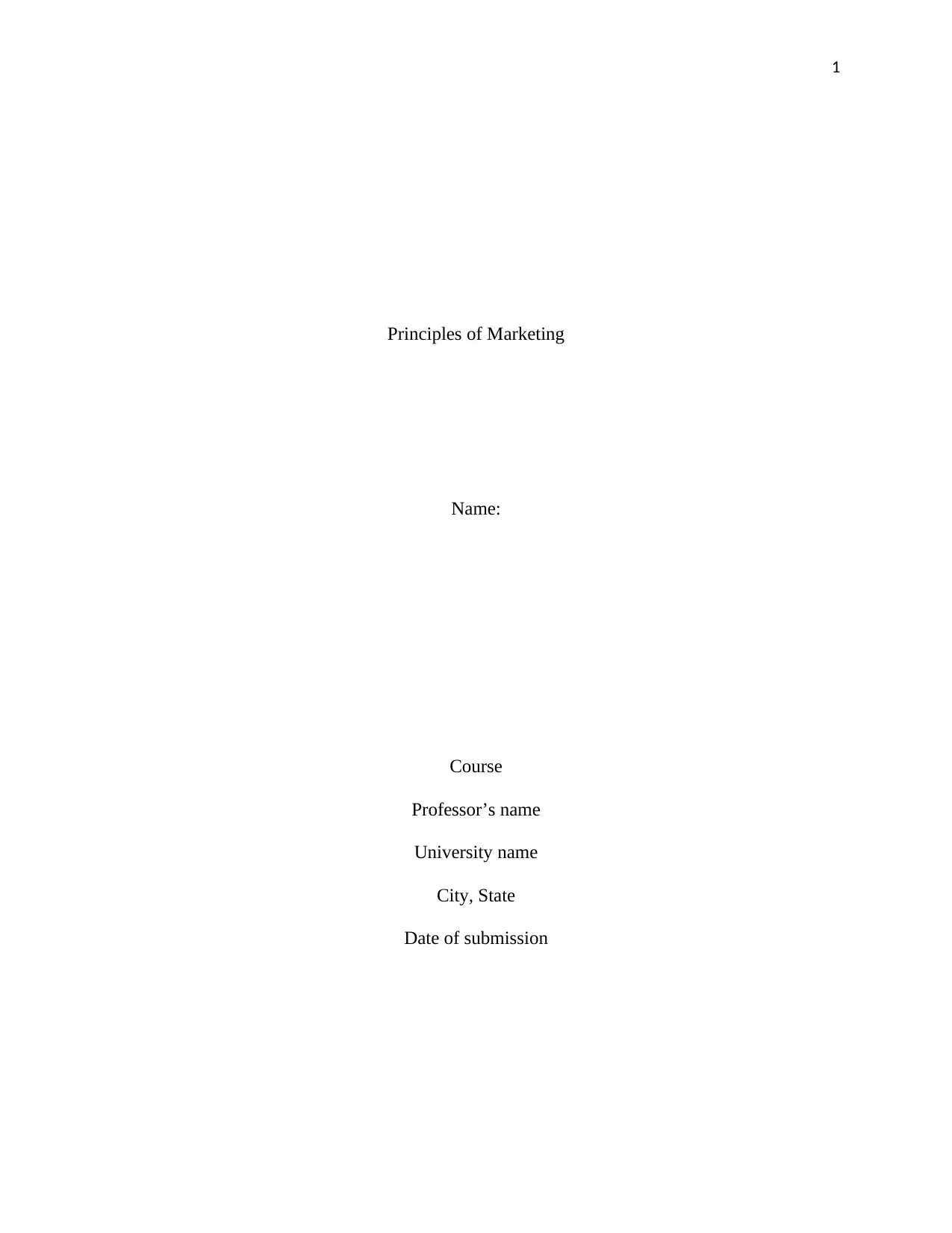
1
Principles of Marketing
Name:
Course
Professor’s name
University name
City, State
Date of submission
Principles of Marketing
Name:
Course
Professor’s name
University name
City, State
Date of submission
Paraphrase This Document
Need a fresh take? Get an instant paraphrase of this document with our AI Paraphraser
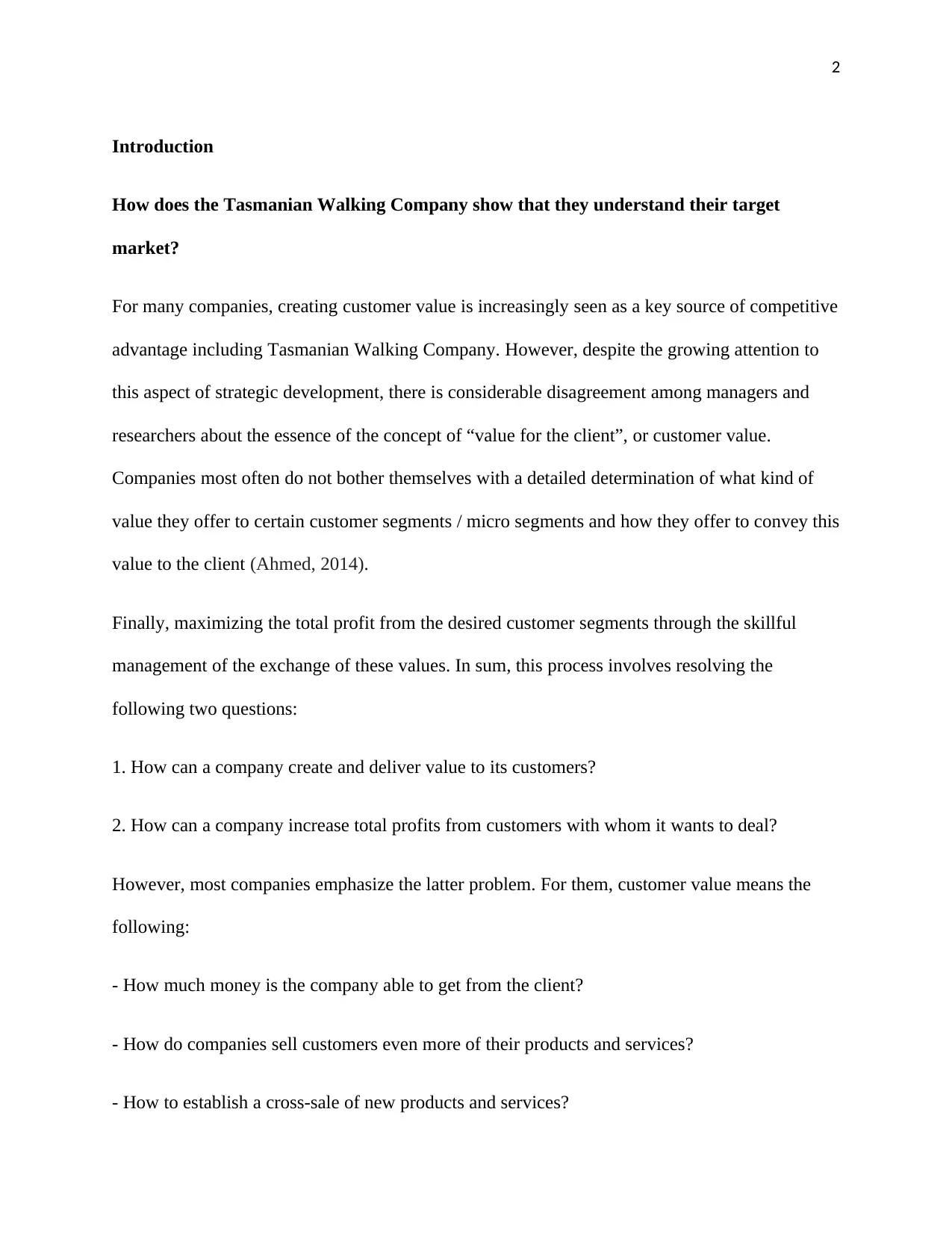
2
Introduction
How does the Tasmanian Walking Company show that they understand their target
market?
For many companies, creating customer value is increasingly seen as a key source of competitive
advantage including Tasmanian Walking Company. However, despite the growing attention to
this aspect of strategic development, there is considerable disagreement among managers and
researchers about the essence of the concept of “value for the client”, or customer value.
Companies most often do not bother themselves with a detailed determination of what kind of
value they offer to certain customer segments / micro segments and how they offer to convey this
value to the client (Ahmed, 2014).
Finally, maximizing the total profit from the desired customer segments through the skillful
management of the exchange of these values. In sum, this process involves resolving the
following two questions:
1. How can a company create and deliver value to its customers?
2. How can a company increase total profits from customers with whom it wants to deal?
However, most companies emphasize the latter problem. For them, customer value means the
following:
- How much money is the company able to get from the client?
- How do companies sell customers even more of their products and services?
- How to establish a cross-sale of new products and services?
Introduction
How does the Tasmanian Walking Company show that they understand their target
market?
For many companies, creating customer value is increasingly seen as a key source of competitive
advantage including Tasmanian Walking Company. However, despite the growing attention to
this aspect of strategic development, there is considerable disagreement among managers and
researchers about the essence of the concept of “value for the client”, or customer value.
Companies most often do not bother themselves with a detailed determination of what kind of
value they offer to certain customer segments / micro segments and how they offer to convey this
value to the client (Ahmed, 2014).
Finally, maximizing the total profit from the desired customer segments through the skillful
management of the exchange of these values. In sum, this process involves resolving the
following two questions:
1. How can a company create and deliver value to its customers?
2. How can a company increase total profits from customers with whom it wants to deal?
However, most companies emphasize the latter problem. For them, customer value means the
following:
- How much money is the company able to get from the client?
- How do companies sell customers even more of their products and services?
- How to establish a cross-sale of new products and services?
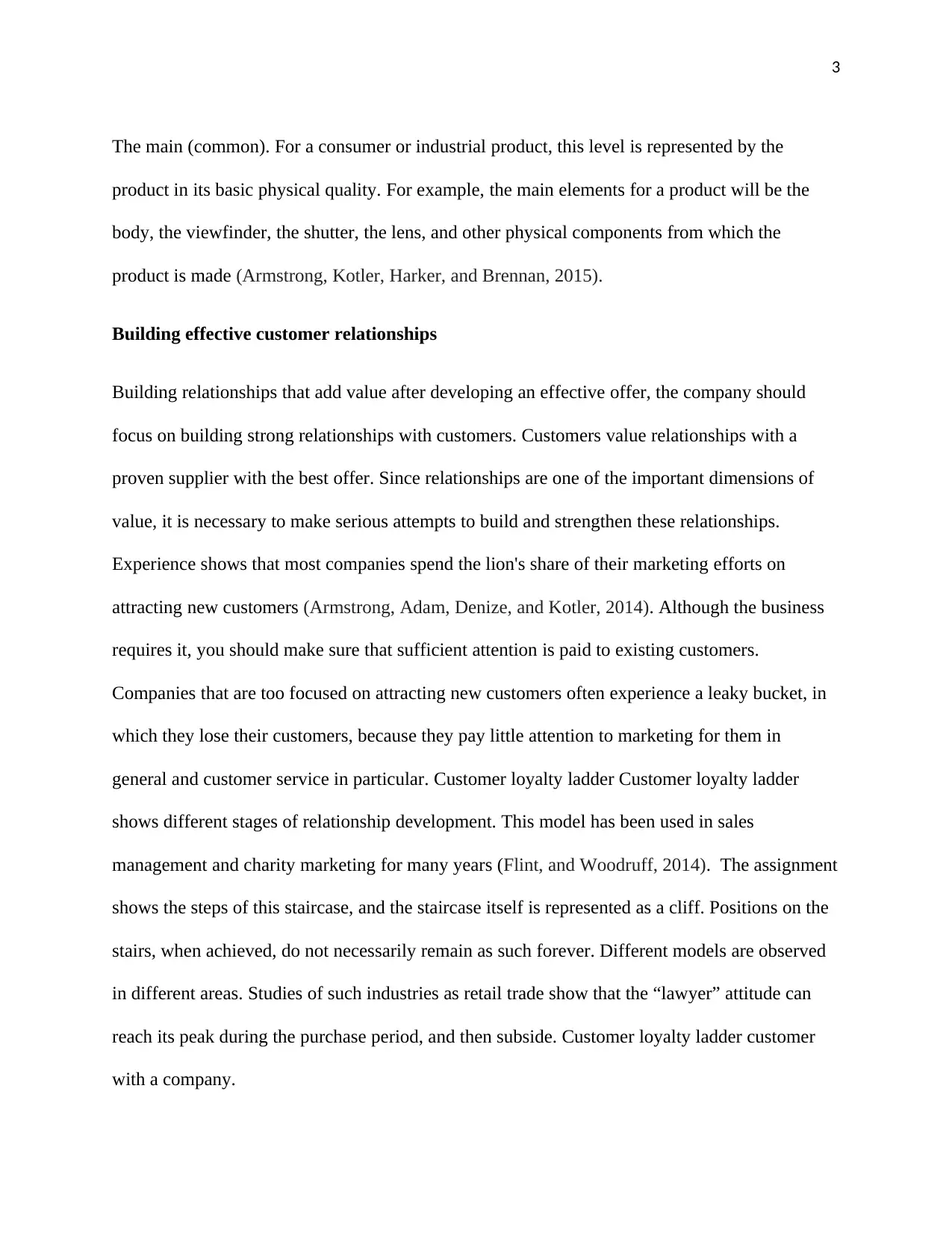
3
The main (common). For a consumer or industrial product, this level is represented by the
product in its basic physical quality. For example, the main elements for a product will be the
body, the viewfinder, the shutter, the lens, and other physical components from which the
product is made (Armstrong, Kotler, Harker, and Brennan, 2015).
Building effective customer relationships
Building relationships that add value after developing an effective offer, the company should
focus on building strong relationships with customers. Customers value relationships with a
proven supplier with the best offer. Since relationships are one of the important dimensions of
value, it is necessary to make serious attempts to build and strengthen these relationships.
Experience shows that most companies spend the lion's share of their marketing efforts on
attracting new customers (Armstrong, Adam, Denize, and Kotler, 2014). Although the business
requires it, you should make sure that sufficient attention is paid to existing customers.
Companies that are too focused on attracting new customers often experience a leaky bucket, in
which they lose their customers, because they pay little attention to marketing for them in
general and customer service in particular. Customer loyalty ladder Customer loyalty ladder
shows different stages of relationship development. This model has been used in sales
management and charity marketing for many years (Flint, and Woodruff, 2014). The assignment
shows the steps of this staircase, and the staircase itself is represented as a cliff. Positions on the
stairs, when achieved, do not necessarily remain as such forever. Different models are observed
in different areas. Studies of such industries as retail trade show that the “lawyer” attitude can
reach its peak during the purchase period, and then subside. Customer loyalty ladder customer
with a company.
The main (common). For a consumer or industrial product, this level is represented by the
product in its basic physical quality. For example, the main elements for a product will be the
body, the viewfinder, the shutter, the lens, and other physical components from which the
product is made (Armstrong, Kotler, Harker, and Brennan, 2015).
Building effective customer relationships
Building relationships that add value after developing an effective offer, the company should
focus on building strong relationships with customers. Customers value relationships with a
proven supplier with the best offer. Since relationships are one of the important dimensions of
value, it is necessary to make serious attempts to build and strengthen these relationships.
Experience shows that most companies spend the lion's share of their marketing efforts on
attracting new customers (Armstrong, Adam, Denize, and Kotler, 2014). Although the business
requires it, you should make sure that sufficient attention is paid to existing customers.
Companies that are too focused on attracting new customers often experience a leaky bucket, in
which they lose their customers, because they pay little attention to marketing for them in
general and customer service in particular. Customer loyalty ladder Customer loyalty ladder
shows different stages of relationship development. This model has been used in sales
management and charity marketing for many years (Flint, and Woodruff, 2014). The assignment
shows the steps of this staircase, and the staircase itself is represented as a cliff. Positions on the
stairs, when achieved, do not necessarily remain as such forever. Different models are observed
in different areas. Studies of such industries as retail trade show that the “lawyer” attitude can
reach its peak during the purchase period, and then subside. Customer loyalty ladder customer
with a company.
⊘ This is a preview!⊘
Do you want full access?
Subscribe today to unlock all pages.

Trusted by 1+ million students worldwide
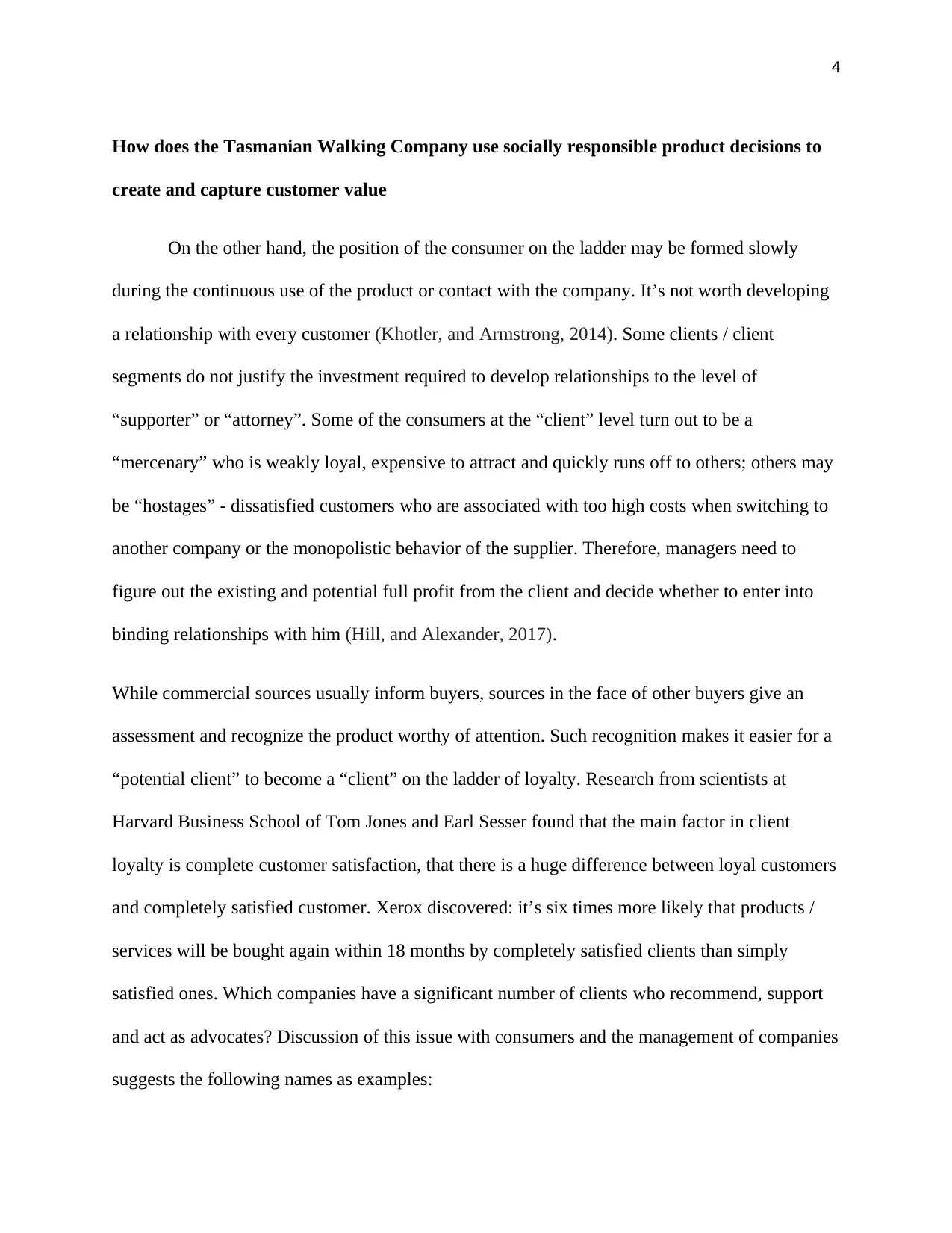
4
How does the Tasmanian Walking Company use socially responsible product decisions to
create and capture customer value
On the other hand, the position of the consumer on the ladder may be formed slowly
during the continuous use of the product or contact with the company. It’s not worth developing
a relationship with every customer (Khotler, and Armstrong, 2014). Some clients / client
segments do not justify the investment required to develop relationships to the level of
“supporter” or “attorney”. Some of the consumers at the “client” level turn out to be a
“mercenary” who is weakly loyal, expensive to attract and quickly runs off to others; others may
be “hostages” - dissatisfied customers who are associated with too high costs when switching to
another company or the monopolistic behavior of the supplier. Therefore, managers need to
figure out the existing and potential full profit from the client and decide whether to enter into
binding relationships with him (Hill, and Alexander, 2017).
While commercial sources usually inform buyers, sources in the face of other buyers give an
assessment and recognize the product worthy of attention. Such recognition makes it easier for a
“potential client” to become a “client” on the ladder of loyalty. Research from scientists at
Harvard Business School of Tom Jones and Earl Sesser found that the main factor in client
loyalty is complete customer satisfaction, that there is a huge difference between loyal customers
and completely satisfied customer. Xerox discovered: it’s six times more likely that products /
services will be bought again within 18 months by completely satisfied clients than simply
satisfied ones. Which companies have a significant number of clients who recommend, support
and act as advocates? Discussion of this issue with consumers and the management of companies
suggests the following names as examples:
How does the Tasmanian Walking Company use socially responsible product decisions to
create and capture customer value
On the other hand, the position of the consumer on the ladder may be formed slowly
during the continuous use of the product or contact with the company. It’s not worth developing
a relationship with every customer (Khotler, and Armstrong, 2014). Some clients / client
segments do not justify the investment required to develop relationships to the level of
“supporter” or “attorney”. Some of the consumers at the “client” level turn out to be a
“mercenary” who is weakly loyal, expensive to attract and quickly runs off to others; others may
be “hostages” - dissatisfied customers who are associated with too high costs when switching to
another company or the monopolistic behavior of the supplier. Therefore, managers need to
figure out the existing and potential full profit from the client and decide whether to enter into
binding relationships with him (Hill, and Alexander, 2017).
While commercial sources usually inform buyers, sources in the face of other buyers give an
assessment and recognize the product worthy of attention. Such recognition makes it easier for a
“potential client” to become a “client” on the ladder of loyalty. Research from scientists at
Harvard Business School of Tom Jones and Earl Sesser found that the main factor in client
loyalty is complete customer satisfaction, that there is a huge difference between loyal customers
and completely satisfied customer. Xerox discovered: it’s six times more likely that products /
services will be bought again within 18 months by completely satisfied clients than simply
satisfied ones. Which companies have a significant number of clients who recommend, support
and act as advocates? Discussion of this issue with consumers and the management of companies
suggests the following names as examples:
Paraphrase This Document
Need a fresh take? Get an instant paraphrase of this document with our AI Paraphraser
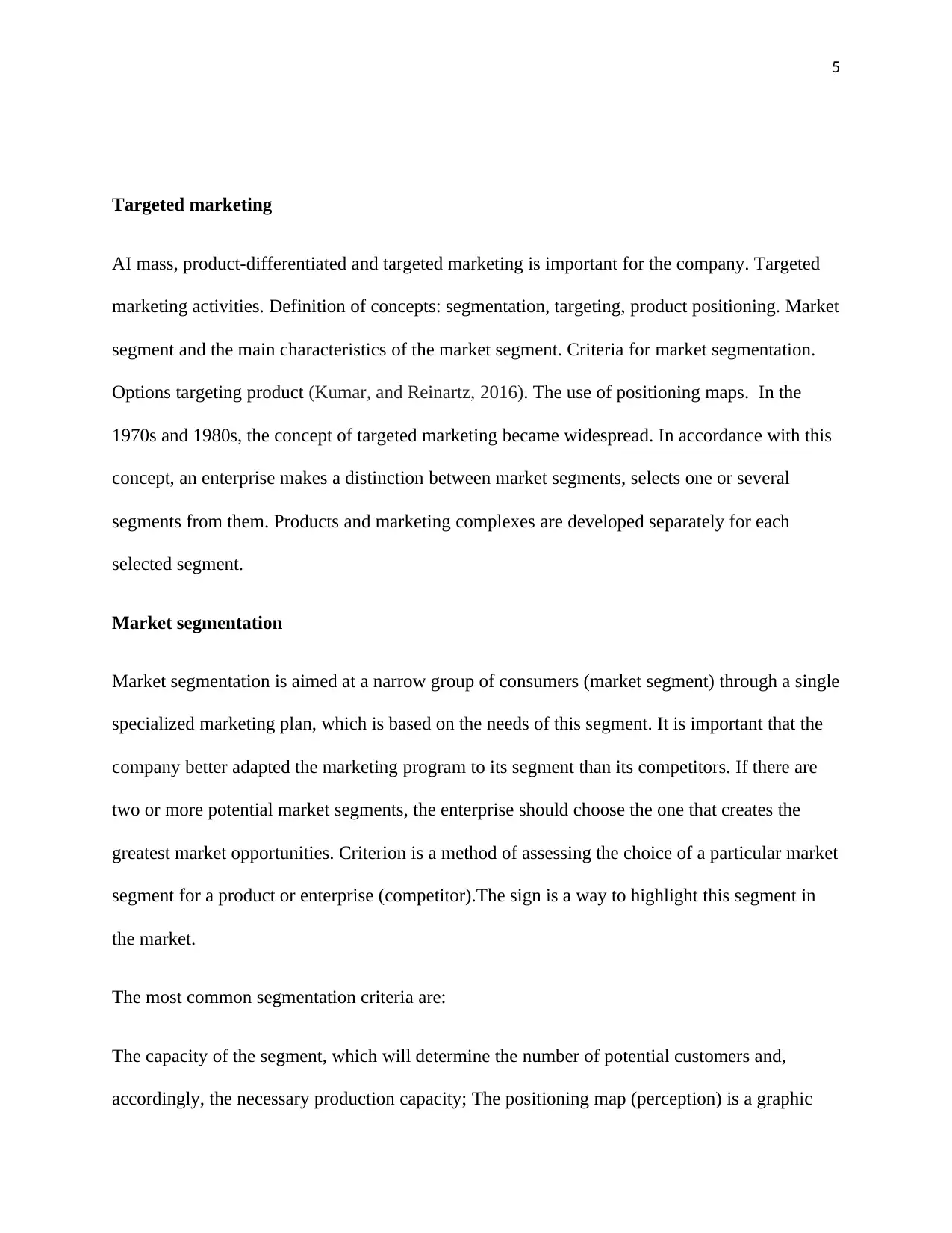
5
Targeted marketing
AI mass, product-differentiated and targeted marketing is important for the company. Targeted
marketing activities. Definition of concepts: segmentation, targeting, product positioning. Market
segment and the main characteristics of the market segment. Criteria for market segmentation.
Options targeting product (Kumar, and Reinartz, 2016). The use of positioning maps. In the
1970s and 1980s, the concept of targeted marketing became widespread. In accordance with this
concept, an enterprise makes a distinction between market segments, selects one or several
segments from them. Products and marketing complexes are developed separately for each
selected segment.
Market segmentation
Market segmentation is aimed at a narrow group of consumers (market segment) through a single
specialized marketing plan, which is based on the needs of this segment. It is important that the
company better adapted the marketing program to its segment than its competitors. If there are
two or more potential market segments, the enterprise should choose the one that creates the
greatest market opportunities. Criterion is a method of assessing the choice of a particular market
segment for a product or enterprise (competitor).The sign is a way to highlight this segment in
the market.
The most common segmentation criteria are:
The capacity of the segment, which will determine the number of potential customers and,
accordingly, the necessary production capacity; The positioning map (perception) is a graphic
Targeted marketing
AI mass, product-differentiated and targeted marketing is important for the company. Targeted
marketing activities. Definition of concepts: segmentation, targeting, product positioning. Market
segment and the main characteristics of the market segment. Criteria for market segmentation.
Options targeting product (Kumar, and Reinartz, 2016). The use of positioning maps. In the
1970s and 1980s, the concept of targeted marketing became widespread. In accordance with this
concept, an enterprise makes a distinction between market segments, selects one or several
segments from them. Products and marketing complexes are developed separately for each
selected segment.
Market segmentation
Market segmentation is aimed at a narrow group of consumers (market segment) through a single
specialized marketing plan, which is based on the needs of this segment. It is important that the
company better adapted the marketing program to its segment than its competitors. If there are
two or more potential market segments, the enterprise should choose the one that creates the
greatest market opportunities. Criterion is a method of assessing the choice of a particular market
segment for a product or enterprise (competitor).The sign is a way to highlight this segment in
the market.
The most common segmentation criteria are:
The capacity of the segment, which will determine the number of potential customers and,
accordingly, the necessary production capacity; The positioning map (perception) is a graphic
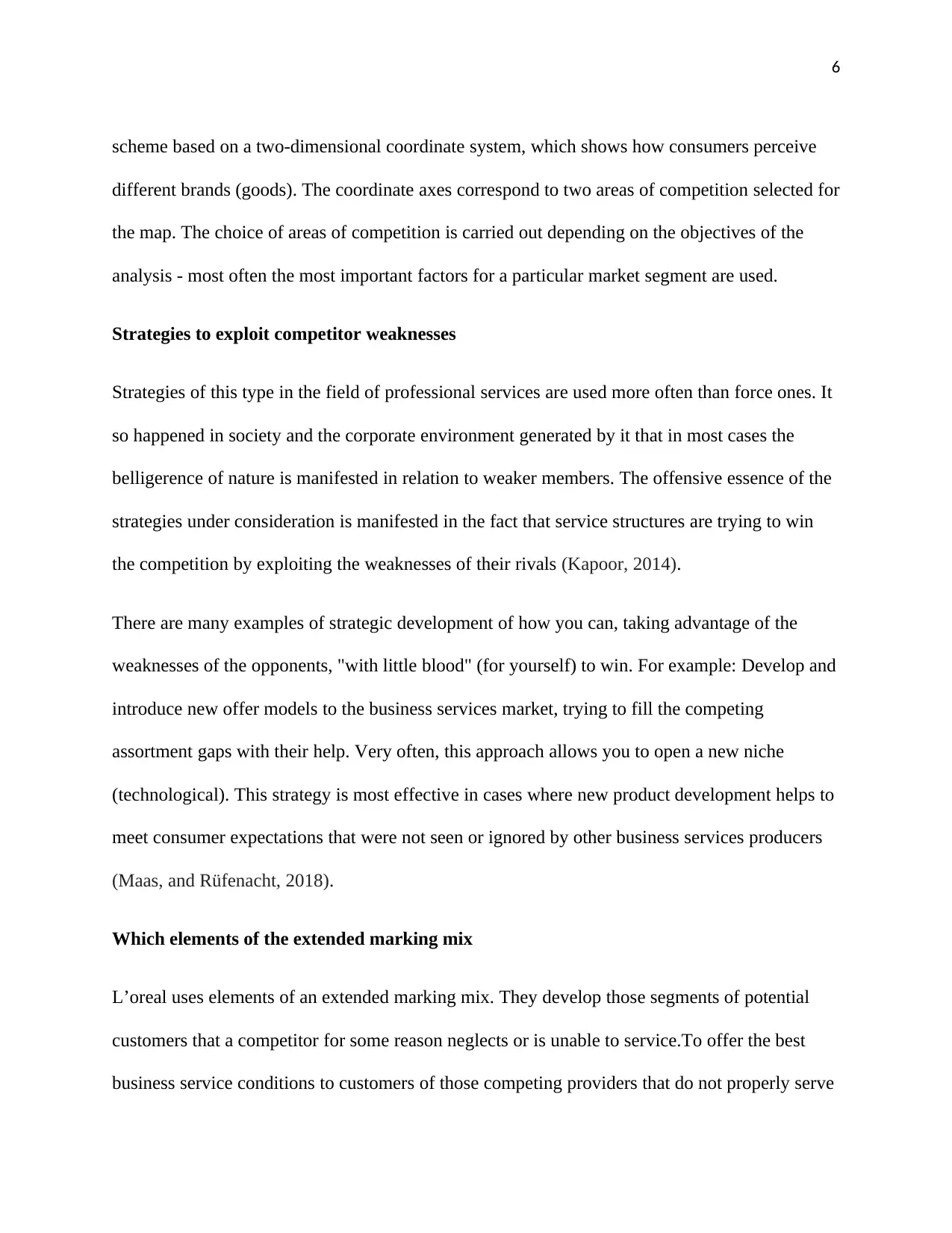
6
scheme based on a two-dimensional coordinate system, which shows how consumers perceive
different brands (goods). The coordinate axes correspond to two areas of competition selected for
the map. The choice of areas of competition is carried out depending on the objectives of the
analysis - most often the most important factors for a particular market segment are used.
Strategies to exploit competitor weaknesses
Strategies of this type in the field of professional services are used more often than force ones. It
so happened in society and the corporate environment generated by it that in most cases the
belligerence of nature is manifested in relation to weaker members. The offensive essence of the
strategies under consideration is manifested in the fact that service structures are trying to win
the competition by exploiting the weaknesses of their rivals (Kapoor, 2014).
There are many examples of strategic development of how you can, taking advantage of the
weaknesses of the opponents, "with little blood" (for yourself) to win. For example: Develop and
introduce new offer models to the business services market, trying to fill the competing
assortment gaps with their help. Very often, this approach allows you to open a new niche
(technological). This strategy is most effective in cases where new product development helps to
meet consumer expectations that were not seen or ignored by other business services producers
(Maas, and Rüfenacht, 2018).
Which elements of the extended marking mix
L’oreal uses elements of an extended marking mix. They develop those segments of potential
customers that a competitor for some reason neglects or is unable to service.To offer the best
business service conditions to customers of those competing providers that do not properly serve
scheme based on a two-dimensional coordinate system, which shows how consumers perceive
different brands (goods). The coordinate axes correspond to two areas of competition selected for
the map. The choice of areas of competition is carried out depending on the objectives of the
analysis - most often the most important factors for a particular market segment are used.
Strategies to exploit competitor weaknesses
Strategies of this type in the field of professional services are used more often than force ones. It
so happened in society and the corporate environment generated by it that in most cases the
belligerence of nature is manifested in relation to weaker members. The offensive essence of the
strategies under consideration is manifested in the fact that service structures are trying to win
the competition by exploiting the weaknesses of their rivals (Kapoor, 2014).
There are many examples of strategic development of how you can, taking advantage of the
weaknesses of the opponents, "with little blood" (for yourself) to win. For example: Develop and
introduce new offer models to the business services market, trying to fill the competing
assortment gaps with their help. Very often, this approach allows you to open a new niche
(technological). This strategy is most effective in cases where new product development helps to
meet consumer expectations that were not seen or ignored by other business services producers
(Maas, and Rüfenacht, 2018).
Which elements of the extended marking mix
L’oreal uses elements of an extended marking mix. They develop those segments of potential
customers that a competitor for some reason neglects or is unable to service.To offer the best
business service conditions to customers of those competing providers that do not properly serve
⊘ This is a preview!⊘
Do you want full access?
Subscribe today to unlock all pages.

Trusted by 1+ million students worldwide
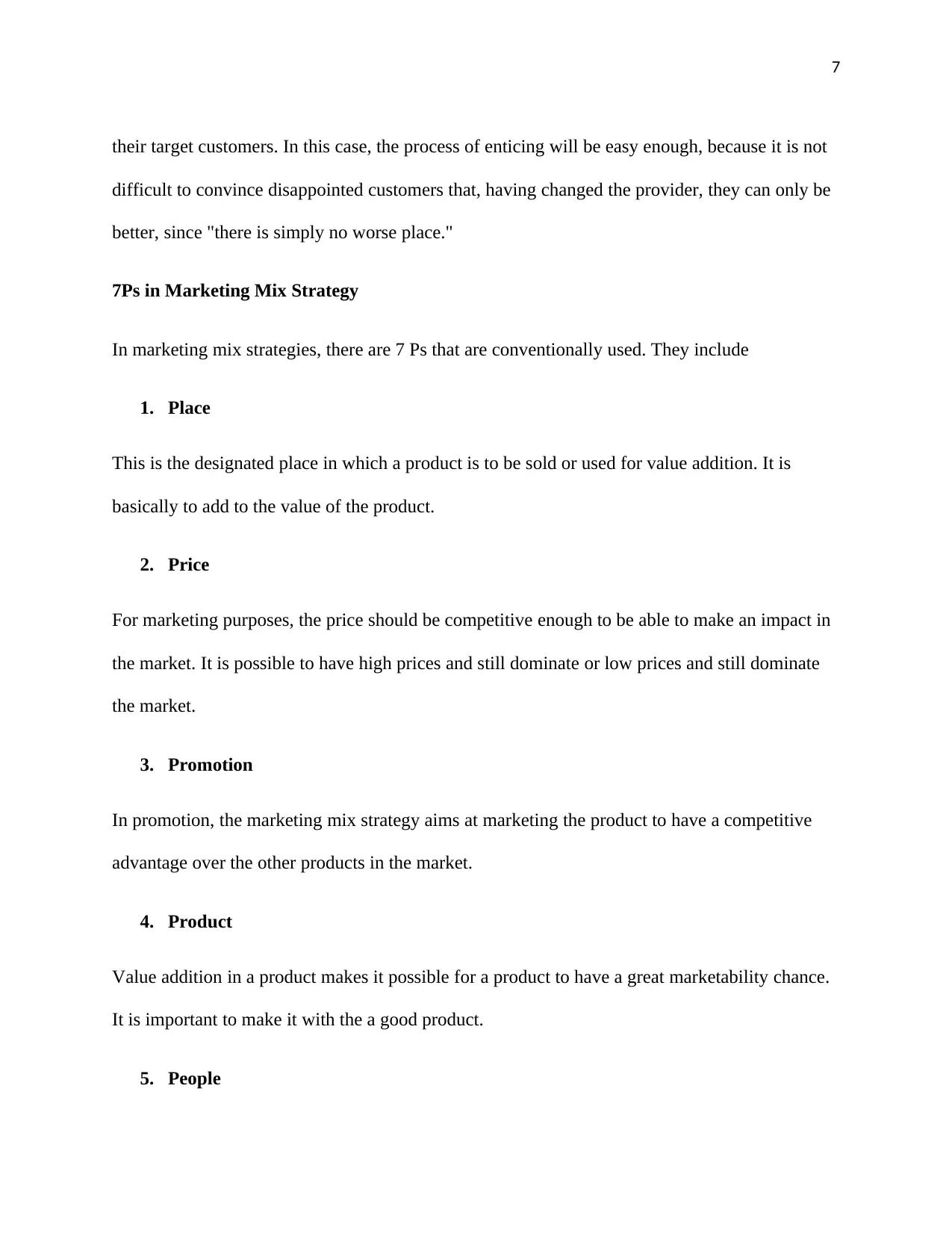
7
their target customers. In this case, the process of enticing will be easy enough, because it is not
difficult to convince disappointed customers that, having changed the provider, they can only be
better, since "there is simply no worse place."
7Ps in Marketing Mix Strategy
In marketing mix strategies, there are 7 Ps that are conventionally used. They include
1. Place
This is the designated place in which a product is to be sold or used for value addition. It is
basically to add to the value of the product.
2. Price
For marketing purposes, the price should be competitive enough to be able to make an impact in
the market. It is possible to have high prices and still dominate or low prices and still dominate
the market.
3. Promotion
In promotion, the marketing mix strategy aims at marketing the product to have a competitive
advantage over the other products in the market.
4. Product
Value addition in a product makes it possible for a product to have a great marketability chance.
It is important to make it with the a good product.
5. People
their target customers. In this case, the process of enticing will be easy enough, because it is not
difficult to convince disappointed customers that, having changed the provider, they can only be
better, since "there is simply no worse place."
7Ps in Marketing Mix Strategy
In marketing mix strategies, there are 7 Ps that are conventionally used. They include
1. Place
This is the designated place in which a product is to be sold or used for value addition. It is
basically to add to the value of the product.
2. Price
For marketing purposes, the price should be competitive enough to be able to make an impact in
the market. It is possible to have high prices and still dominate or low prices and still dominate
the market.
3. Promotion
In promotion, the marketing mix strategy aims at marketing the product to have a competitive
advantage over the other products in the market.
4. Product
Value addition in a product makes it possible for a product to have a great marketability chance.
It is important to make it with the a good product.
5. People
Paraphrase This Document
Need a fresh take? Get an instant paraphrase of this document with our AI Paraphraser
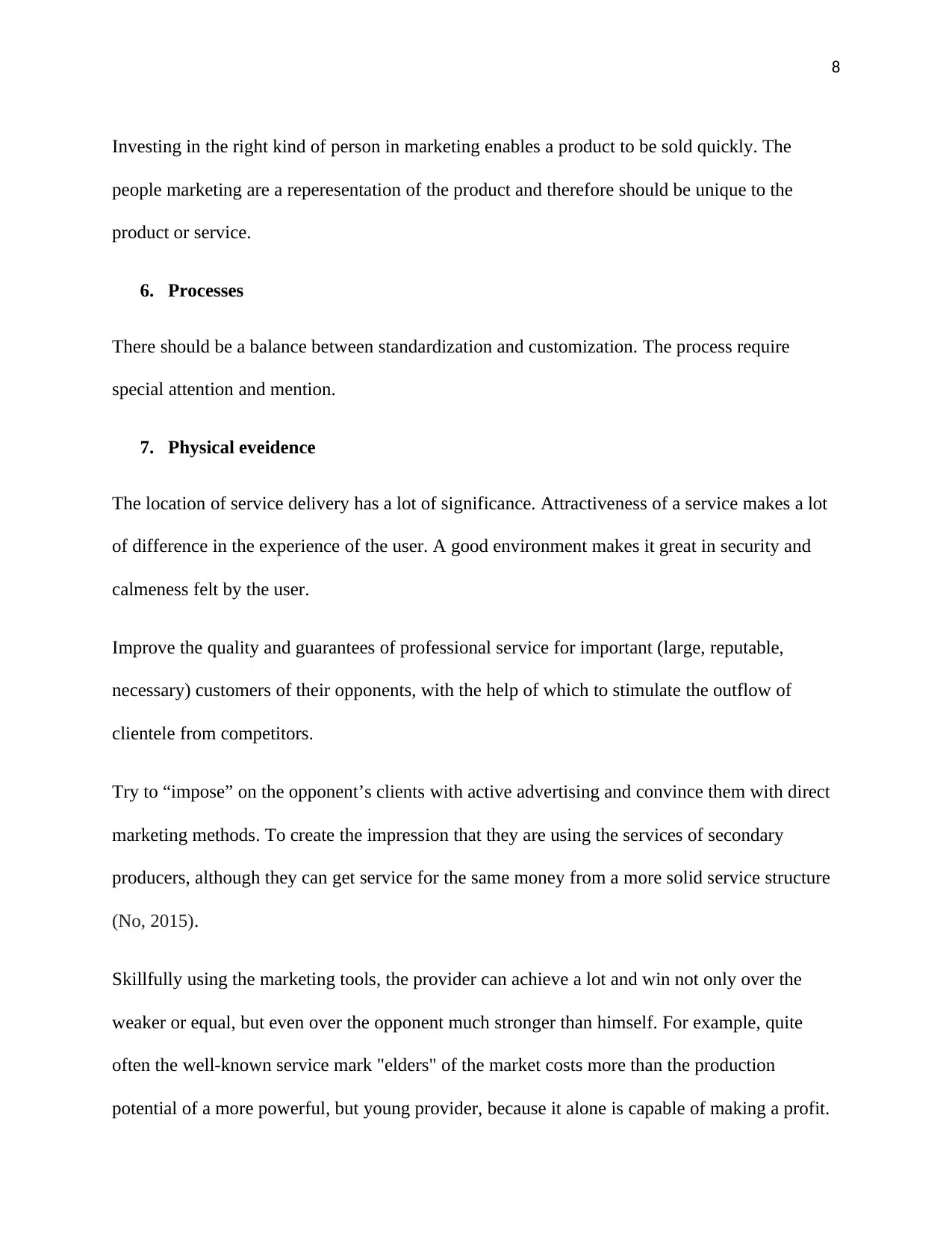
8
Investing in the right kind of person in marketing enables a product to be sold quickly. The
people marketing are a reperesentation of the product and therefore should be unique to the
product or service.
6. Processes
There should be a balance between standardization and customization. The process require
special attention and mention.
7. Physical eveidence
The location of service delivery has a lot of significance. Attractiveness of a service makes a lot
of difference in the experience of the user. A good environment makes it great in security and
calmeness felt by the user.
Improve the quality and guarantees of professional service for important (large, reputable,
necessary) customers of their opponents, with the help of which to stimulate the outflow of
clientele from competitors.
Try to “impose” on the opponent’s clients with active advertising and convince them with direct
marketing methods. To create the impression that they are using the services of secondary
producers, although they can get service for the same money from a more solid service structure
(No, 2015).
Skillfully using the marketing tools, the provider can achieve a lot and win not only over the
weaker or equal, but even over the opponent much stronger than himself. For example, quite
often the well-known service mark "elders" of the market costs more than the production
potential of a more powerful, but young provider, because it alone is capable of making a profit.
Investing in the right kind of person in marketing enables a product to be sold quickly. The
people marketing are a reperesentation of the product and therefore should be unique to the
product or service.
6. Processes
There should be a balance between standardization and customization. The process require
special attention and mention.
7. Physical eveidence
The location of service delivery has a lot of significance. Attractiveness of a service makes a lot
of difference in the experience of the user. A good environment makes it great in security and
calmeness felt by the user.
Improve the quality and guarantees of professional service for important (large, reputable,
necessary) customers of their opponents, with the help of which to stimulate the outflow of
clientele from competitors.
Try to “impose” on the opponent’s clients with active advertising and convince them with direct
marketing methods. To create the impression that they are using the services of secondary
producers, although they can get service for the same money from a more solid service structure
(No, 2015).
Skillfully using the marketing tools, the provider can achieve a lot and win not only over the
weaker or equal, but even over the opponent much stronger than himself. For example, quite
often the well-known service mark "elders" of the market costs more than the production
potential of a more powerful, but young provider, because it alone is capable of making a profit.
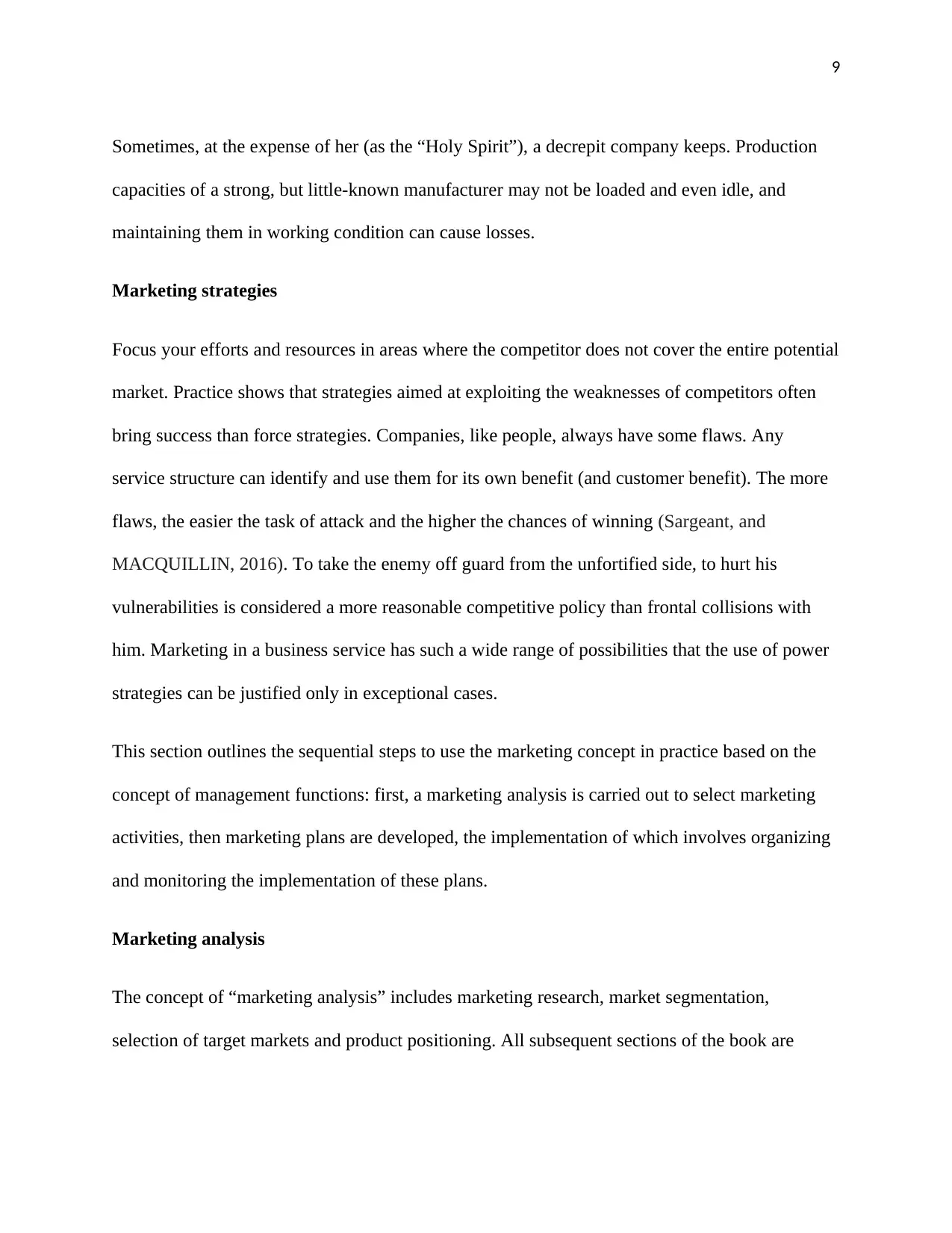
9
Sometimes, at the expense of her (as the “Holy Spirit”), a decrepit company keeps. Production
capacities of a strong, but little-known manufacturer may not be loaded and even idle, and
maintaining them in working condition can cause losses.
Marketing strategies
Focus your efforts and resources in areas where the competitor does not cover the entire potential
market. Practice shows that strategies aimed at exploiting the weaknesses of competitors often
bring success than force strategies. Companies, like people, always have some flaws. Any
service structure can identify and use them for its own benefit (and customer benefit). The more
flaws, the easier the task of attack and the higher the chances of winning (Sargeant, and
MACQUILLIN, 2016). To take the enemy off guard from the unfortified side, to hurt his
vulnerabilities is considered a more reasonable competitive policy than frontal collisions with
him. Marketing in a business service has such a wide range of possibilities that the use of power
strategies can be justified only in exceptional cases.
This section outlines the sequential steps to use the marketing concept in practice based on the
concept of management functions: first, a marketing analysis is carried out to select marketing
activities, then marketing plans are developed, the implementation of which involves organizing
and monitoring the implementation of these plans.
Marketing analysis
The concept of “marketing analysis” includes marketing research, market segmentation,
selection of target markets and product positioning. All subsequent sections of the book are
Sometimes, at the expense of her (as the “Holy Spirit”), a decrepit company keeps. Production
capacities of a strong, but little-known manufacturer may not be loaded and even idle, and
maintaining them in working condition can cause losses.
Marketing strategies
Focus your efforts and resources in areas where the competitor does not cover the entire potential
market. Practice shows that strategies aimed at exploiting the weaknesses of competitors often
bring success than force strategies. Companies, like people, always have some flaws. Any
service structure can identify and use them for its own benefit (and customer benefit). The more
flaws, the easier the task of attack and the higher the chances of winning (Sargeant, and
MACQUILLIN, 2016). To take the enemy off guard from the unfortified side, to hurt his
vulnerabilities is considered a more reasonable competitive policy than frontal collisions with
him. Marketing in a business service has such a wide range of possibilities that the use of power
strategies can be justified only in exceptional cases.
This section outlines the sequential steps to use the marketing concept in practice based on the
concept of management functions: first, a marketing analysis is carried out to select marketing
activities, then marketing plans are developed, the implementation of which involves organizing
and monitoring the implementation of these plans.
Marketing analysis
The concept of “marketing analysis” includes marketing research, market segmentation,
selection of target markets and product positioning. All subsequent sections of the book are
⊘ This is a preview!⊘
Do you want full access?
Subscribe today to unlock all pages.

Trusted by 1+ million students worldwide
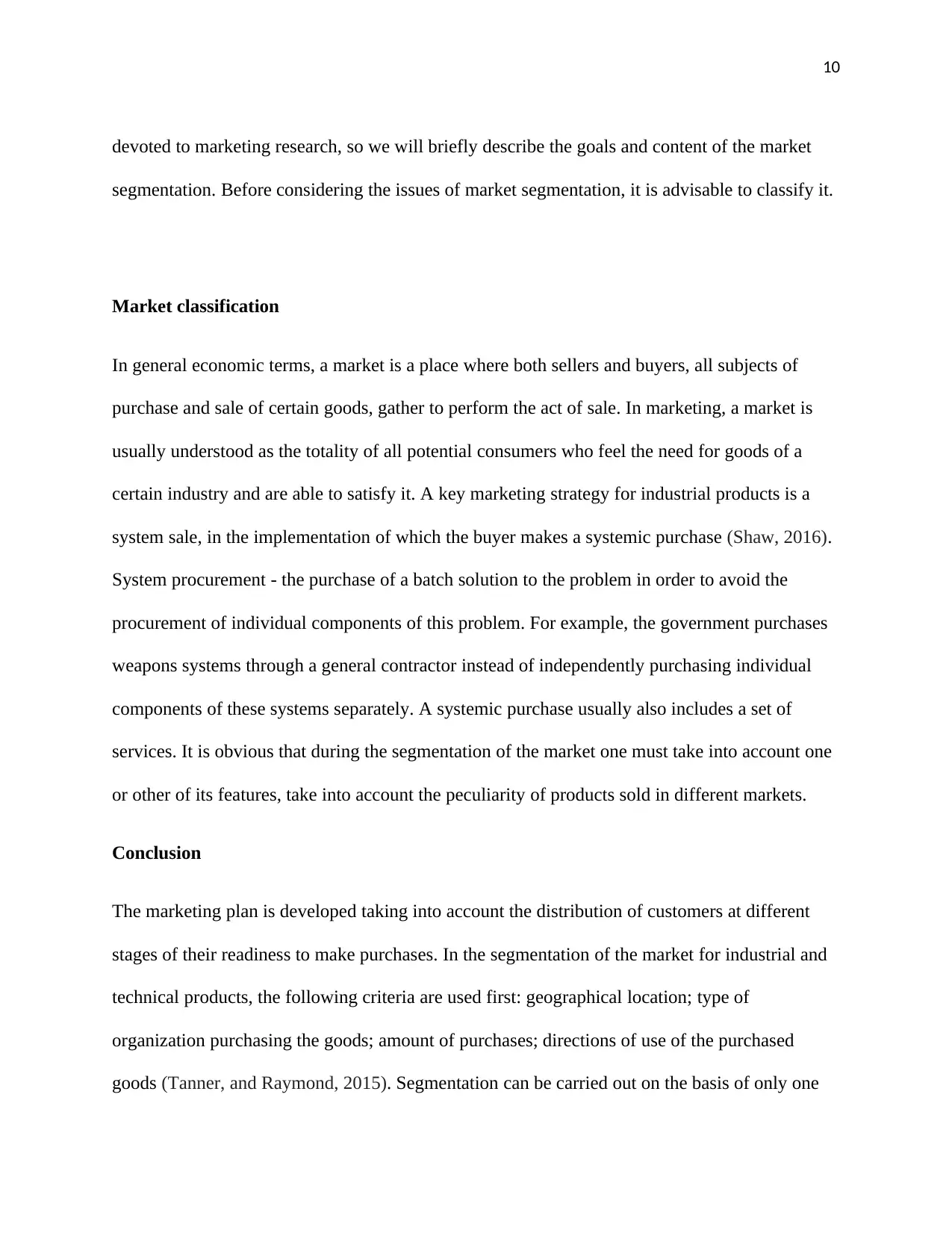
10
devoted to marketing research, so we will briefly describe the goals and content of the market
segmentation. Before considering the issues of market segmentation, it is advisable to classify it.
Market classification
In general economic terms, a market is a place where both sellers and buyers, all subjects of
purchase and sale of certain goods, gather to perform the act of sale. In marketing, a market is
usually understood as the totality of all potential consumers who feel the need for goods of a
certain industry and are able to satisfy it. A key marketing strategy for industrial products is a
system sale, in the implementation of which the buyer makes a systemic purchase (Shaw, 2016).
System procurement - the purchase of a batch solution to the problem in order to avoid the
procurement of individual components of this problem. For example, the government purchases
weapons systems through a general contractor instead of independently purchasing individual
components of these systems separately. A systemic purchase usually also includes a set of
services. It is obvious that during the segmentation of the market one must take into account one
or other of its features, take into account the peculiarity of products sold in different markets.
Conclusion
The marketing plan is developed taking into account the distribution of customers at different
stages of their readiness to make purchases. In the segmentation of the market for industrial and
technical products, the following criteria are used first: geographical location; type of
organization purchasing the goods; amount of purchases; directions of use of the purchased
goods (Tanner, and Raymond, 2015). Segmentation can be carried out on the basis of only one
devoted to marketing research, so we will briefly describe the goals and content of the market
segmentation. Before considering the issues of market segmentation, it is advisable to classify it.
Market classification
In general economic terms, a market is a place where both sellers and buyers, all subjects of
purchase and sale of certain goods, gather to perform the act of sale. In marketing, a market is
usually understood as the totality of all potential consumers who feel the need for goods of a
certain industry and are able to satisfy it. A key marketing strategy for industrial products is a
system sale, in the implementation of which the buyer makes a systemic purchase (Shaw, 2016).
System procurement - the purchase of a batch solution to the problem in order to avoid the
procurement of individual components of this problem. For example, the government purchases
weapons systems through a general contractor instead of independently purchasing individual
components of these systems separately. A systemic purchase usually also includes a set of
services. It is obvious that during the segmentation of the market one must take into account one
or other of its features, take into account the peculiarity of products sold in different markets.
Conclusion
The marketing plan is developed taking into account the distribution of customers at different
stages of their readiness to make purchases. In the segmentation of the market for industrial and
technical products, the following criteria are used first: geographical location; type of
organization purchasing the goods; amount of purchases; directions of use of the purchased
goods (Tanner, and Raymond, 2015). Segmentation can be carried out on the basis of only one
Paraphrase This Document
Need a fresh take? Get an instant paraphrase of this document with our AI Paraphraser
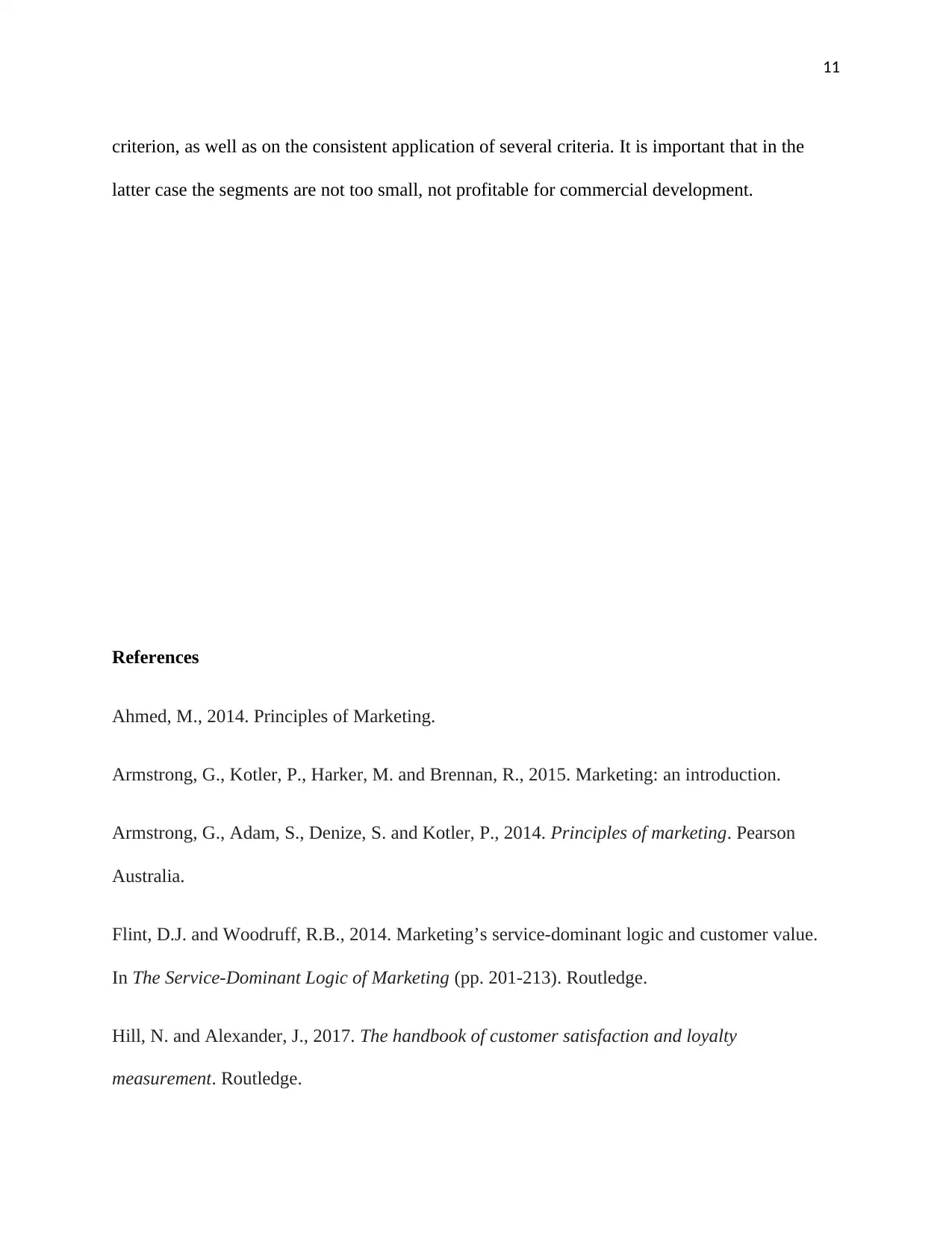
11
criterion, as well as on the consistent application of several criteria. It is important that in the
latter case the segments are not too small, not profitable for commercial development.
References
Ahmed, M., 2014. Principles of Marketing.
Armstrong, G., Kotler, P., Harker, M. and Brennan, R., 2015. Marketing: an introduction.
Armstrong, G., Adam, S., Denize, S. and Kotler, P., 2014. Principles of marketing. Pearson
Australia.
Flint, D.J. and Woodruff, R.B., 2014. Marketing’s service-dominant logic and customer value.
In The Service-Dominant Logic of Marketing (pp. 201-213). Routledge.
Hill, N. and Alexander, J., 2017. The handbook of customer satisfaction and loyalty
measurement. Routledge.
criterion, as well as on the consistent application of several criteria. It is important that in the
latter case the segments are not too small, not profitable for commercial development.
References
Ahmed, M., 2014. Principles of Marketing.
Armstrong, G., Kotler, P., Harker, M. and Brennan, R., 2015. Marketing: an introduction.
Armstrong, G., Adam, S., Denize, S. and Kotler, P., 2014. Principles of marketing. Pearson
Australia.
Flint, D.J. and Woodruff, R.B., 2014. Marketing’s service-dominant logic and customer value.
In The Service-Dominant Logic of Marketing (pp. 201-213). Routledge.
Hill, N. and Alexander, J., 2017. The handbook of customer satisfaction and loyalty
measurement. Routledge.
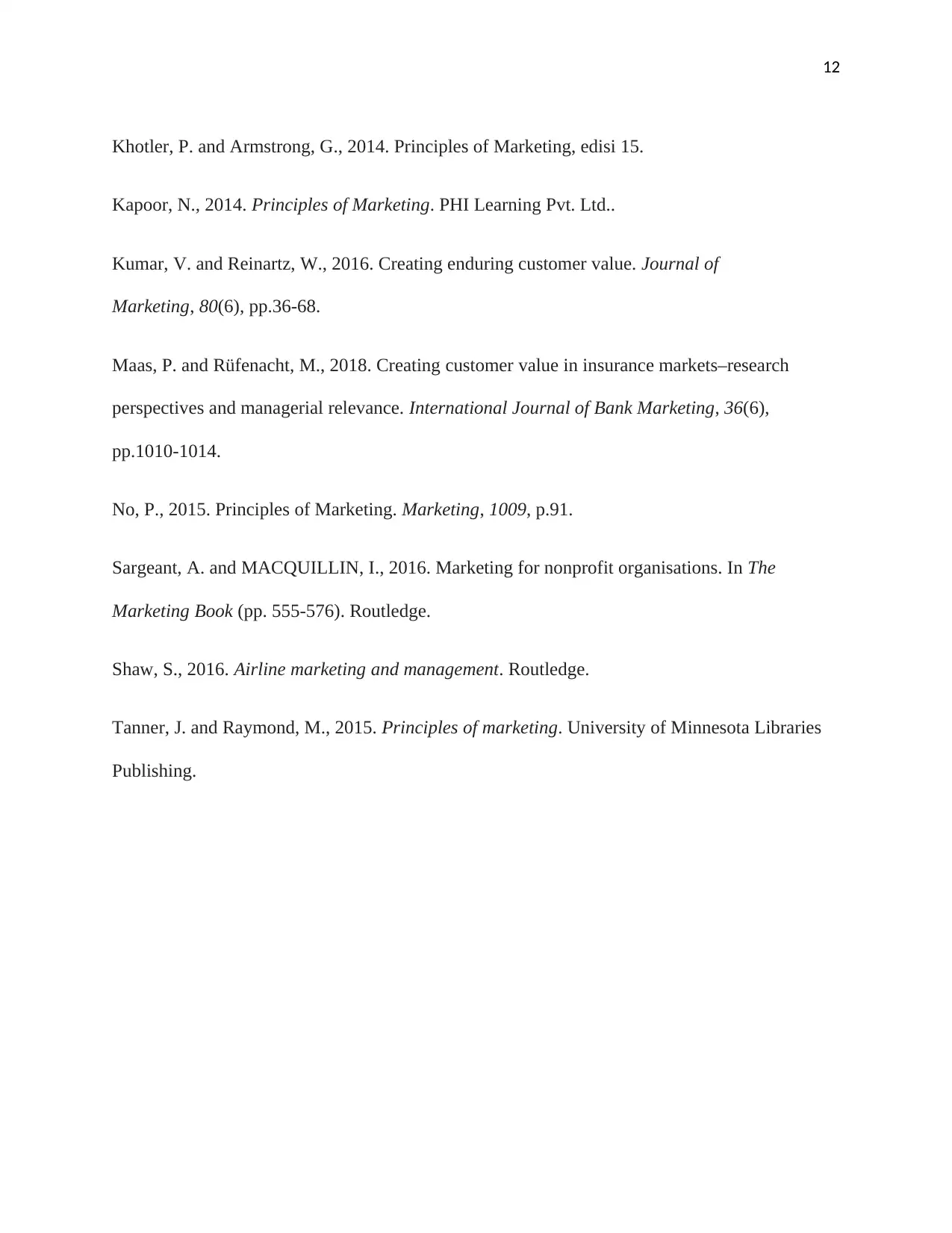
12
Khotler, P. and Armstrong, G., 2014. Principles of Marketing, edisi 15.
Kapoor, N., 2014. Principles of Marketing. PHI Learning Pvt. Ltd..
Kumar, V. and Reinartz, W., 2016. Creating enduring customer value. Journal of
Marketing, 80(6), pp.36-68.
Maas, P. and Rüfenacht, M., 2018. Creating customer value in insurance markets–research
perspectives and managerial relevance. International Journal of Bank Marketing, 36(6),
pp.1010-1014.
No, P., 2015. Principles of Marketing. Marketing, 1009, p.91.
Sargeant, A. and MACQUILLIN, I., 2016. Marketing for nonprofit organisations. In The
Marketing Book (pp. 555-576). Routledge.
Shaw, S., 2016. Airline marketing and management. Routledge.
Tanner, J. and Raymond, M., 2015. Principles of marketing. University of Minnesota Libraries
Publishing.
Khotler, P. and Armstrong, G., 2014. Principles of Marketing, edisi 15.
Kapoor, N., 2014. Principles of Marketing. PHI Learning Pvt. Ltd..
Kumar, V. and Reinartz, W., 2016. Creating enduring customer value. Journal of
Marketing, 80(6), pp.36-68.
Maas, P. and Rüfenacht, M., 2018. Creating customer value in insurance markets–research
perspectives and managerial relevance. International Journal of Bank Marketing, 36(6),
pp.1010-1014.
No, P., 2015. Principles of Marketing. Marketing, 1009, p.91.
Sargeant, A. and MACQUILLIN, I., 2016. Marketing for nonprofit organisations. In The
Marketing Book (pp. 555-576). Routledge.
Shaw, S., 2016. Airline marketing and management. Routledge.
Tanner, J. and Raymond, M., 2015. Principles of marketing. University of Minnesota Libraries
Publishing.
⊘ This is a preview!⊘
Do you want full access?
Subscribe today to unlock all pages.

Trusted by 1+ million students worldwide
1 out of 12
Related Documents
Your All-in-One AI-Powered Toolkit for Academic Success.
+13062052269
info@desklib.com
Available 24*7 on WhatsApp / Email
![[object Object]](/_next/static/media/star-bottom.7253800d.svg)
Unlock your academic potential
Copyright © 2020–2025 A2Z Services. All Rights Reserved. Developed and managed by ZUCOL.





